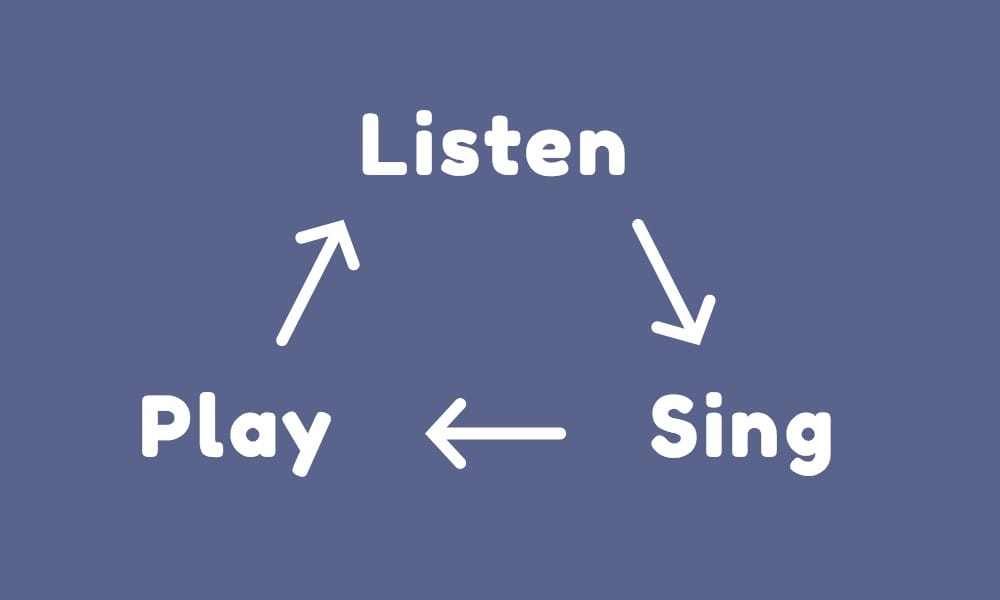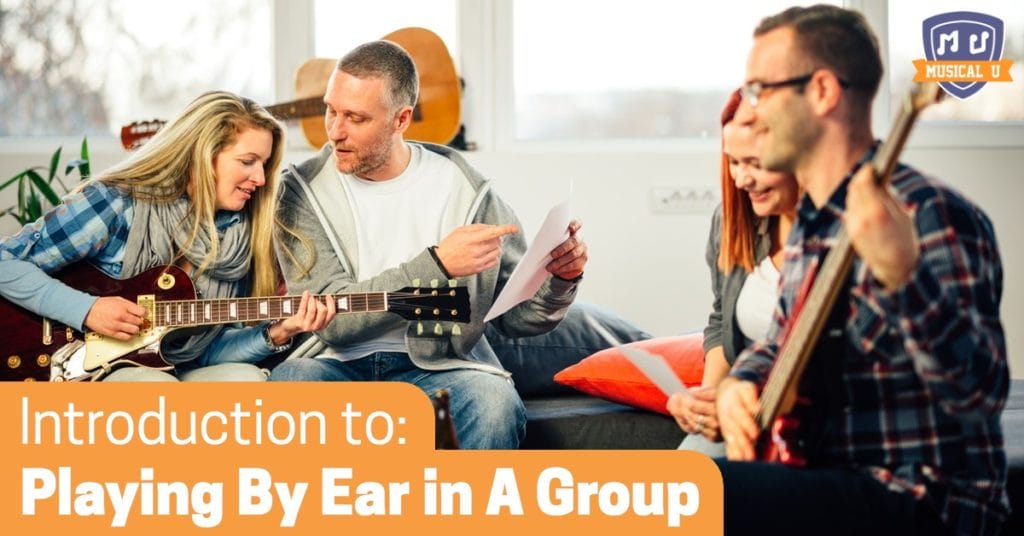Playing by ear is an oft-neglected skill that opens up countless doors for you as an improviser, performer, band member, and composer. You won’t always have sheet music available to you, and many musical styles are built on learning music by ear rather than off the page.
If you want to play as freely and musically as possible, this is your ticket.
Most of the playing by ear that we do is individual – we sit and figure out how to translate a piece of music onto our instrument. When we get into a band setting, we often do it together, but still in a semi-individual manner.
But what if you’ve never played by ear before, and no one in your band has either?
Collectively learning to play a song by ear can seem like a daunting task, but it can be done. Thanks to my 10-year career of teaching music to kids in large groups, I have a few tricks up my sleeve for teaching the skill of playing by ear in a beginner group setting. For the purposes of this post, I will use “Lean on Me” by Bill Withers, as it is a widely recognizable song. All of the same concepts can apply to any song you are learning.
Step 1: Before the first note
Before you even touch the instruments, you really need to listen. I don’t mean listen casually, I mean really listen. Listen for what instruments you hear in the song. Try and notice any patterns you might hear or what sounds are being used. Once you know what instruments are in the song, write them down or take note of them somehow.
For many who have never learned by ear before, the tendency is to focus only on the vocal parts because that is the part we can hear most clearly. You really have to focus your listening on a particular sound, just like your eyes can focus on a particular object.
If you and your group are having trouble listening to just the instrument parts, try finding a good karaoke version of the song you are learning online. These have the vocal parts removed, which makes it easier to hear just the instruments.
“Lean on Me” has a very audible piano part that is easily distinguishable – try starting there. If you are still having trouble hearing the parts, have your group add movement to the part.
A practical use for air guitar…

Adding physical movement doesn’t necessarily mean to dance to the part – it can be much simpler.
Find the instrumental part with your ears, and use some part of your body (an arm or just a hand) to show the melodic movement or chord patterns in the music. It could be mimicking the instrument you are listening for. For example, if it is the string section that you are trying to hear, try to mimic playing a violin or cello along with the part. You’ll be surprised at how much easier it becomes to hear an instrumental part by drawing attention to it through movement – and you’ll understand why a conductor is so important for an orchestra!
Step 2: The First Note
I highly recommend everyone learning the parts on one melodic instrument that you all know how to play. In a classroom setting, I would be having my students learn the piano part on Orff percussion instruments because they all know how to play them with little practice.
I know that most people do not have access to these specialized educational instruments. You may use a mix of instruments, but they should all have melodic capability (i.e., no drums). The reason for this is to make sure everyone is on the same page when you all go your separate ways to learn the other parts as a group. If you all know how the song goes, it will drastically cut down on learning time later.
The first chord in “Lean on Me” is clearly audible at the very start of the song:
We are going to try and figure out the first root note of the chord which is also clearly audible. On your audio device, play the recording you have of “Lean on Me”, but stop it directly after the first sound – do not let it get to the next chord. After you stop it, sing it immediately.
Being able to sing it directly predicts your success with learning by ear – if you can sing it, you can learn it by ear. The note you sing should be the root note that you are trying to find. Once you sing it, try and find it on the instrument. Repeat the listen-sing-play cycle until you’ve found it. Depending on your level, this could take anywhere from 10 seconds to several minutes.
Step 3: Piecing it Up
 Once the first note is established, you can begin to learn the entire riff. If you have lots of experience with music, this step could be really short. If not, it will take a bit longer.
Once the first note is established, you can begin to learn the entire riff. If you have lots of experience with music, this step could be really short. If not, it will take a bit longer.
If you haven’t found out already, the first note is a C. Then, you just repeat listen-sing-play, adding more of the song until you have the entire riff learned.
If this is completely new to you and your group, I recommend listening to only three or four notes at a time, or two measures at a time, until you learn it. Stop and scrub it (scroll it back) as many times as you and your group need to.
Step 4: Pick Up the Other Instruments
Once you and your group have the main keyboard riff learned, apply what you just learned to the other instruments – now that you have the foundation of the song worked out, everything will be easier. You can begin to copy the recording exactly or make your own arrangements of the song to give it your own group twist. Chords on the piano are easier to form than on other instruments, so if you have a piano, you will likely be able to figure out the chords once you know the root notes of the riff.
Songs that Work Well for Those New to Playing By Ear
Here are some songs that can be very easily used with this process due to their repetitive riffs. Songs with a lot of chords and pitches are much more difficult to pick up for learners that are new to playing by ear.
These songs will be relatively easy to learn and can be simplified easily as well:
“Stompa” – Serena Ryder
“Eye of the Tiger” – Survivor
“Stand by Me” – Ben E. King
“You Really Got Me” – The Kinks
“All Day and All of the Night” – The Kinks
“Louie, Louie” – the Kingsmen
“I Love Rock n’ Roll” – Joan Jett
Playing by Ear, Any Way You Want
Although this post has primarily focussed on playing by ear in a group setting, much of this can be applied directly to individuals, too.
If you are a music teacher in a classroom, this will be a great starting point for you. Playing by ear and collaboration seem to be forgotten skills for many classically trained musicians – and this is the perfect way to teach these useful skills.
If you are looking for something more in-depth with some philosophy behind it, please check out my book, Rock Coach: A Practical Guide for Teaching Rock Bands in Schools, available on Amazon. In it, I discuss not only rock bands, but the learning practices of rock musicians which includes the process of learning to play by ear. If you have any questions or comments, please do not hesitate to contact me.
If you are learning to play by ear solo, simply follow these steps with your instrument – and you can try the riff you learn on other instruments to further solidify your learning.
Most importantly: no matter which setting you’re learning to play by ear with – remember that the first step is to really listen to the music!
Giving attention to the patterns and instruments in a song right from the beginning will ensure you’re not only learning and playing, but also understanding.








